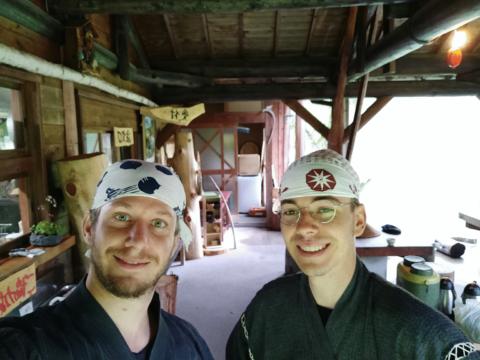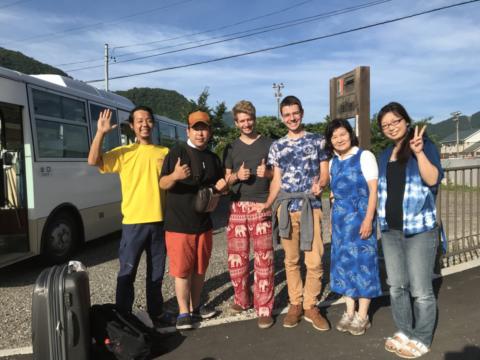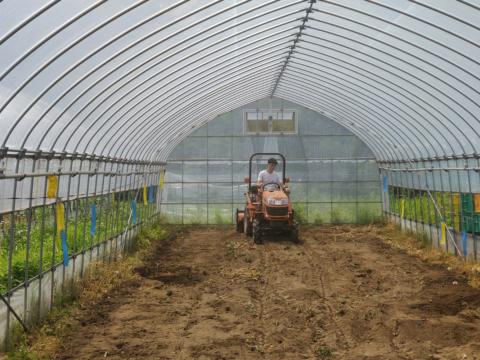Only 900€ per week!
Community Agriculture
Nagano - Japan
Community Agriculture
Nagano - Japan
Work side by side with local farmers and learn from them how to plant and harvest crops, protect them from animals and preserve them for winter time.
The population in and around the village of Otaki is aging while young Japanese are leaving, pursuing a life and work in one of the big cities. The older population, staying in Otaki, appreciates a helping hand in their daily tasks. But even more so, they enjoy the company and the chance to share their knowledge and experience.
Program Description
Farming in Japan is different from farming in North America or the US. The mountainous Japanese landscape doesn’t allow for big, stretched out fields. Instead many people run their own little farms, tugged into the hills.
The village of Otaki is no different. Many of its inhabitants are growing vegetables and crops, some have animals. They sell their harvest on local markets or in regional supermarkets. But while the younger generation leaves the countryside, the work is getting harder for the ones who stay.
Most people in and around Otaki follow a rather traditional Japanese lifestyle. Their houses merge western elements with traditional Japanese architecture. But with the young generation leaving the countryside, many of the elders are increasingly afraid of their customs dying with them. More than you helping them in their daily work, they appreciate the chance to teach you about their work and their culture.
For Japanese farmers the day typically starts with sunrise. You may be asked to get up early to do some first chores before breakfast. Throughout the rest of the day more work awaits. Depending on the season and weather, expect about 2-5 hours of work per day. During spring, summer and autumn, the work will be mostly outdoors. Tasks e.g. could be:
- Fertilizing fields
- Plowing fields
- Planting / harvesting
- Maintaining fences to keep out the monkeys and wild boars
- Maintaining the water supply system
During late autumn and winter most work would be done inside. This is when Japanese farmers process their harvest to conserve it throughout the winter or dedicate themselves to local handicraft. Tasks could e.g. be:
- Processing the harvest to conserve it
- Preparing conserved meals
- Local handicraft
- Preparations for the upcoming spring
- Scraping snow
Besides your work on the farm, you will join other participants in Otaki to learn about local culture and explore the surroundings.
Please note that during the months of January and February participants will assist the elders in the community with snow removal and can engage in winter sports such as sledding or snow trekking as well as the other weather permitting activities described.
Aims & Objectives
- Give the locals company and a chance to share their culture and experience
- Support them in their farming tasks
Schedule
Monday to Friday
- You may be asked to help out on the farm in the early morning
- Breakfast
- Perform a variety of outdoor or indoor tasks
- Lunch
- Cultural or outdoor activities together will all participants in Otaki
- Complete additional tasks on the farm
- Dinner
- Cultural or outdoor activities together will all participants in Otaki
Note: This schedule can be changed and/or amended depending on weather conditions, local conditions and unforeseen circumstances.
Participant Criteria & Requirements
Standard Requirements
Minimum age: –
Maximum age: –
Minimum English level: Basic
CRB required: On Signup
Passport copy required: No
Resume copy required: No
Required qualification: None
Additional Requirements
There are no further requirements for this program.
Additional Equipment
There are no further requirements for this program.
Location
Your time in the Nagano Prefecture of Japan will be spent in a small village, amid spectacular mountains, with just about 800 residents. Otaki is a wonderland of nature that hosts many guests, especially during the winter months when there is a nice coat of snow on Mt. Ontake. Japan’s second highest volcano not only is home to a ski resort, but also attracts many spiritual groups and forms of Buddhism. Mt. Ontake is surrounded by an array of different shrines and sacred places and a popular destination for pilgrims.
About the Accommodation
While in Otaki, Nagano, Japan you will be staying in a local Homestay or at our participant accommodation (possibility for some amazing camping in a tent during warmer months)10-25 minutes outside of the village by car. Please keep in mind the toilet and shower for the Green House location near the restaurant and campsite are separate from the sleeping accommodation. The homestay at the house provides toilet and shower inside. There may also be a pet dog around the Green House location.
Food Arrangements
Weekdays you will enjoy three meals a day (breakfast, lunch and dinner) and two on weekends, during your stay. Meals will be local cuisine and you can expect that they will include rice and vegetables.
Facilities
The village of Otaki features an ATM, two convenience stores and a post office. These may not be in walking distance from your accommodation, but you’ll have the chance to stop by there several times during the week.
Activities & Events
Monday to Friday
Besides your program you will join some cultural or outdoor activities every day. These depend on the season and local circumstances. Some examples:
- Visit typical local neighborhood house
- Learn about Japanese bathing culture and how Japanese shower
- Visit a natural hot spring
- Take a traditional bath over a fire
- Learn about local plants and flowers
- Go to the river and cool down
- Learn how to make origami
- Join a Matcha tea ceremony
- Trek up a hill to a viewpoint. Spot animal traces on the way.
- Learn how to make sushi
- Dye textiles with natural colors
- Go to Otaki’s convenience store and ATM
- Climb up to a sacred shrine above Otaki
- Trek on the pilgrims trail leading up into the mountains
- Join a traditional purification ceremony under a sacred waterfall
- Make Japanese paper
- Practice Kendo (Japanese sword fighting)
Sights & Surroundings
Otaki is a nature lover’s paradise with many outdoor activities possible year round. Great place for skiing, snowboarding, hiking, biking and kayaking on the lake. Major points of interest include: Mt. Ontake, Shintaki Waterfall and Tanoharatenen Park.
Transportation
From this location we do not provide free transport to other locations.
Quick Facts
Name: Japan
Population: 127 mil
Capital: Tokyo
Language: Japanese
Currency: Japanese Yen (JPY)
Time zone: JST (UTC +9)
Country Information
Japan is an East Asian island nation located in the Pacific Ocean. It is made up of 6852 islands, but the vast majority of its size and population are made up of only 4. Neighboring countries include the People’s Republic of China, Taiwan, North and South Korea, the Philippines, Russia and the Northern Mariana Islands. Japan is an extremely homogenous nation with 98.5% of its 127 million person population being of Japanese descent. That being the case, Japan is a country steeped in tradition and cultural heritage. They have great respect for the past, and honor their elders. At the same time, modern Japan is a powerhouse in the region and the world. They have one of the highest levels of education in the world and many of their companies are leaders in technology. Japan’s economy is strong and they import and export goods globally, which makes them a great presence around the world.
Climate
When visiting Japan pay attention to the time of the year, because it has all four seasons. You can expect the winter to be freezing cold and the summer to be hot. Temperatures average between -10 degrees celsius in winter and 25 degrees celsius in the summer, but there can be some days that expand beyond that scope greatly. Spring and autumn are fairly mild and bring gifts of cherry blossoms and gentle breezes.
Culture
Embracing the old and the new, Japan culture is as much Geisha and it is Anime. As much Samurai and Kabuki and it is Nintendo and Karaoke. There seems to be a continued reverence for the traditions of the past and an eager expectation for things of the future. Technology is in the forefront and guiding the throngs of residents in this country, as they embrace things they appreciate about U.S. and European culture and expand it to fit their own Asian culture and lifestyles.
Gastronomy
The tastes of Japan never cease to amaze and delight. Here you can find whatever you like, as international cuisine is everywhere. But if your goal is to sample what’s cooking in the Japanese kitchen then get your palate and your chopsticks ready. What you eat may vary by region or season, but expect everything to be fresh and delicious. Street foods like the charcoal grilled chicken skewers called Yakitori, or Okonomiyaki which are thin pancakes which come with savory fillings, can satisfy a craving or two. You also might want to check out some of the best noodles around, Soba are hearty buckwheat noodles and of course the world famous Ramen are egg noodles on a whole other level. With both, the real game changer is the broth ,which take these dishes to a whole other level. Who can visit Japan and not try Sushi? It may be rice and raw fish, but it sure is delish! If you are more of a carnivore then maybe a bit of the decadent Shabu-Shabu (meat cooked in boiling liquid) or Tonkatsu (deep-fried pork cutlets) will tickle your fancy! Whatever your tastes, there is something for you here!
Transportation
Even though Japan is covered in mountains, it has a very developed train system. Connection between all bigger cities leave several times an hour and until late at night. There are bus connections too, slightly more affordable than the quite high priced trains.
When planning train or bus travel, Google Maps may not be accurate or not contain certain connections at all. Check out the app ‘NAVITIME for JapanTravel’ (Android / iOS) or similar services for more complete and correct timetables.
On the countryside, bus connections are rather infrequent, even more so on Sundays and holidays.
For intra-city travel you can count on a network of buses, trams, underground metros and of course taxis to take you from point A to B.




